深入分析AFL源码,对理解AFL的设计理念和其中用到的技巧有着巨大的帮助,对于后期进行定制化Fuzzer开发也具有深刻的指导意义。所以,阅读AFL源码是学习AFL必不可少的一个关键步骤。
考虑到AFL源码规模,源码分析部分将分为几期进行。
当别人都要快的时候,你要慢下来。
首先在宏观上看一下AFL的源码结构:
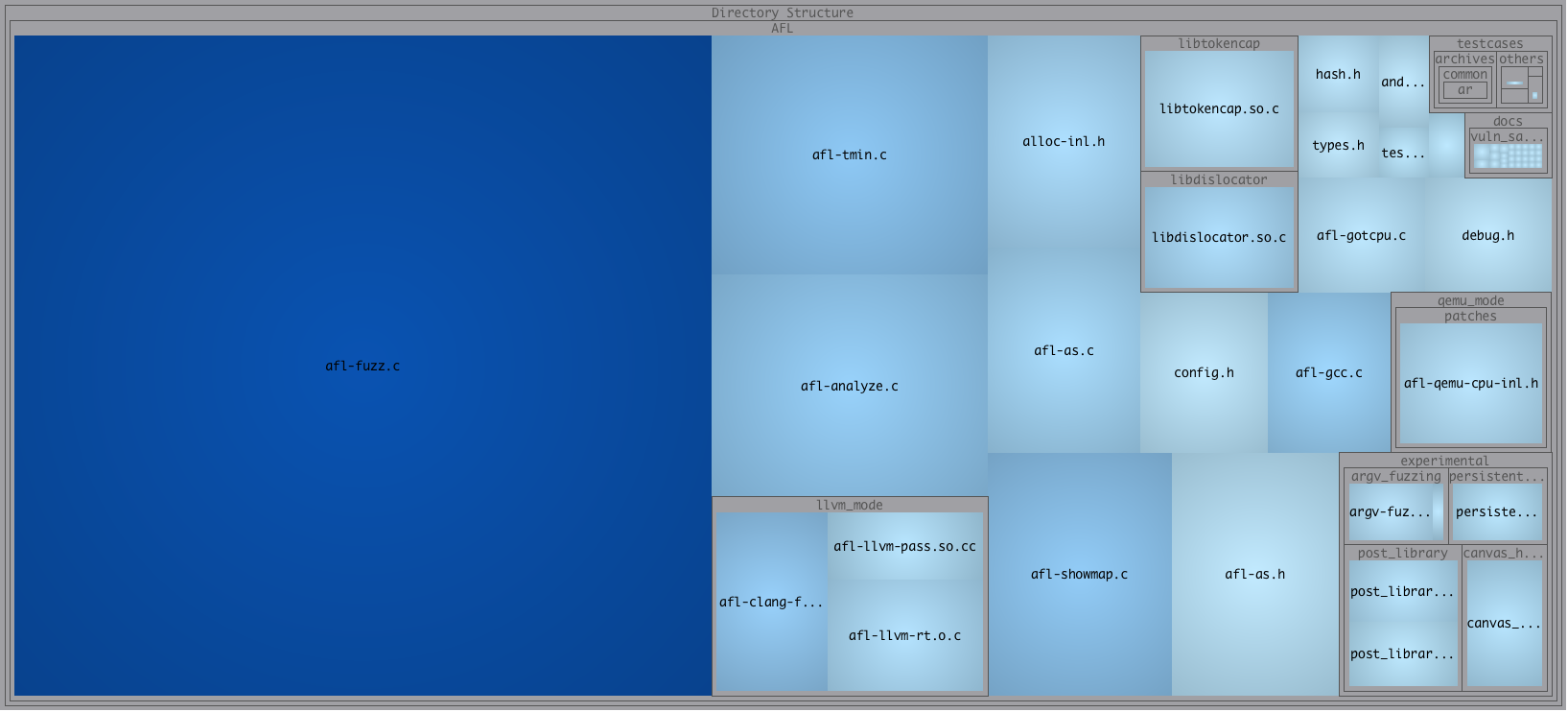
主要的代码在 afl-fuzz.c 文件中,然后是几个独立功能的实现代码,llvm_mode 和 qemu_mode 的代码量大致相当,所以分析的重点应该还是在AFL的根目录下的几个核心功能的实现上,尤其是 afl-fuzz.c,属于核心中的重点。
各个模块的主要功能和作用:
插桩模块
fuzzer 模块
afl-fuzz.c:fuzzer 实现的核心代码,AFL 的主体。
其他辅助模块
部分头文件说明
afl-gcc 是GCC 或 clang 的一个wrapper(封装),常规的使用方法是在调用 ./configure 时通过 CC 将路径传递给 afl-gcc 或 afl-clang。(对于 C++ 代码,使用 CXX 并将其指向 afl-g++ / afl-clang++。)afl-clang, afl-clang++, afl-g++ 均为指向 afl-gcc 的一个符号链接。
afl-gcc 的主要作用是实现对于关键节点的代码插桩,属于汇编级,从而记录程序执行路径之类的关键信息,对程序的运行情况进行反馈。
在开始函数代码分析前,首先要明确几个关键变量:
main 函数全部逻辑如下:

其中主要有如下三个函数的调用:
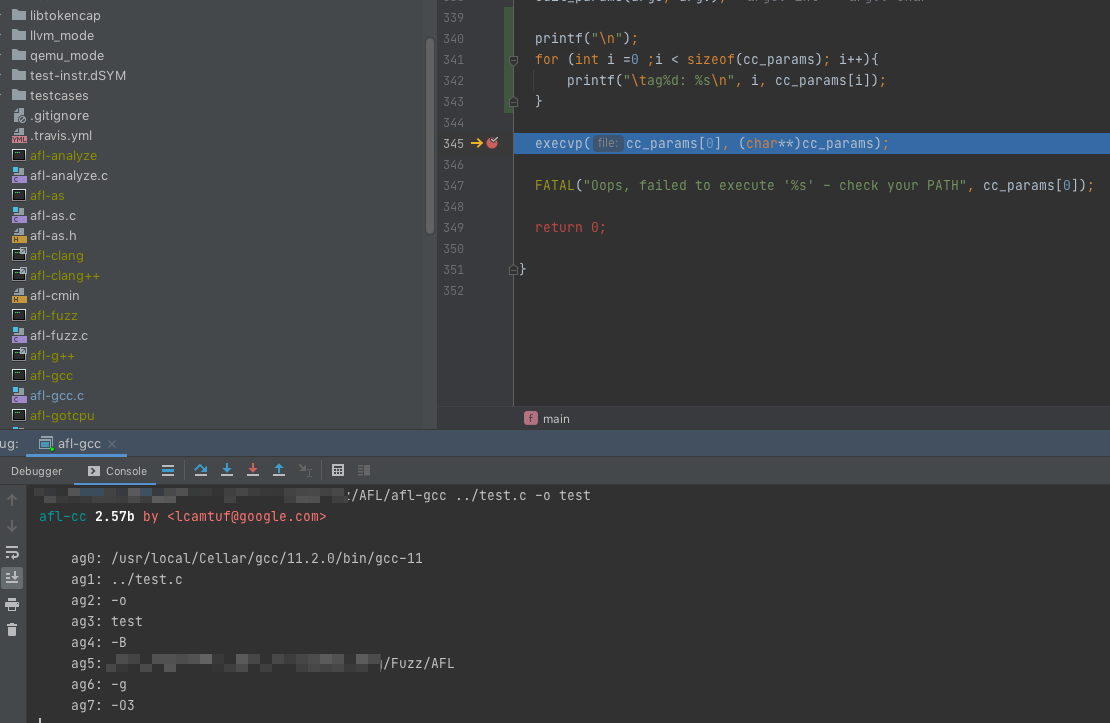
这里添加了部分代码打印出传入的参数 arg[0] - arg[7] ,其中一部分是我们指定的参数,另外一部分是自动添加的编译选项(之前的原理文章的插桩部分有简单介绍)。
函数的核心作用:寻找 afl-as
/ Try to find our "fake" GNU assembler in AFL_PATH or at the location derived from argv[0]. If that fails, abort. /
函数内部大概的流程如下(软件自动生成,控制流程图存在误差,但关键逻辑没有问题):
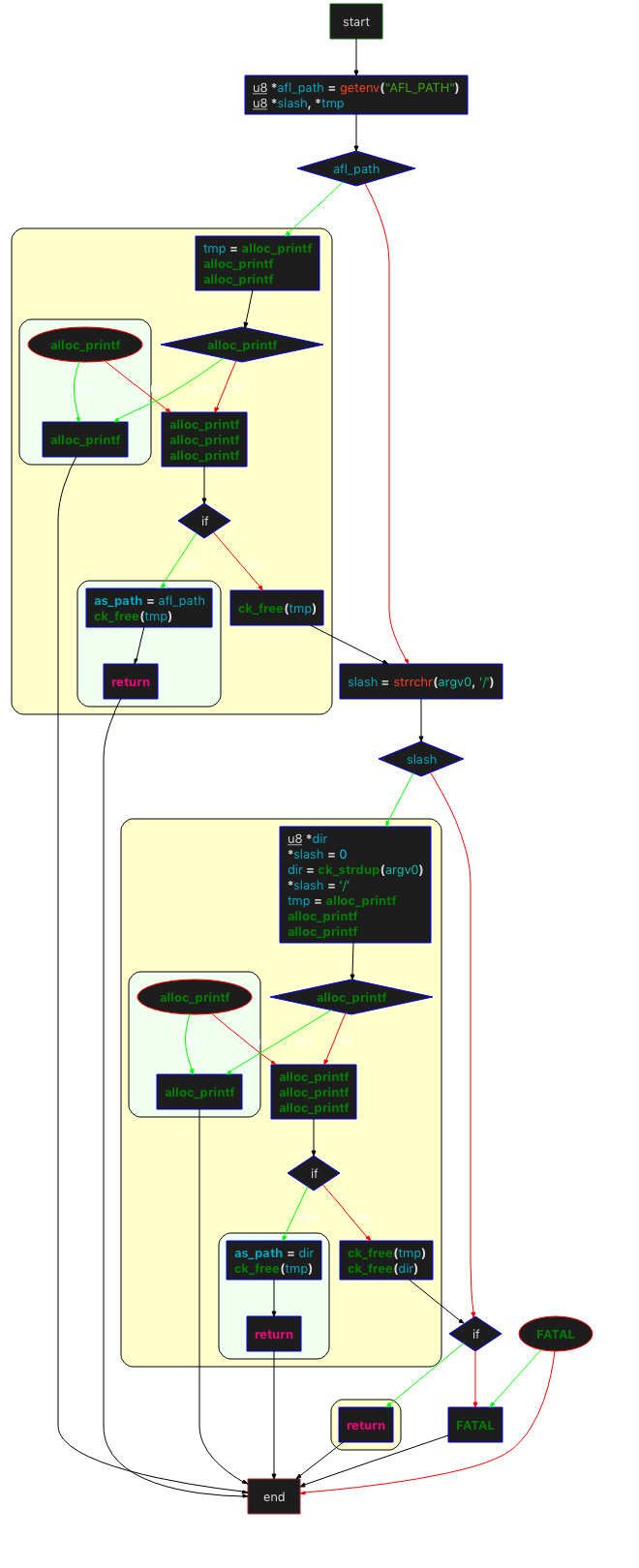
核心作用:将 argv 拷贝到 u8 **cc_params,然后进行相应的处理。
/ Copy argv to cc_params, making the necessary edits. /
函数内部的大概流程如下:

调用 ch_alloc() 为 cc_params 分配大小为 (argc + 128) * 8 的内存(u8的类型为1byte无符号整数)
检查 argv[0] 中是否存在/,如果不存在则 name = argv[0],如果存在则一直找到最后一个/,并将其后面的字符串赋值给 name
对比 name和固定字符串afl-clang:
若相同,设置clang_mode = 1,设置环境变量CLANG_ENV_VAR为1
如果不相同,并且是Apple平台,会进入 #ifdef __APPLE__。在Apple平台下,开始对 name 进行对比,并通过 cc_params[0] = getenv("") 对cc_params[0]进行赋值;如果是非Apple平台,对比 name 和 固定字符串afl-g++(此处忽略对Java环境的处理过程):
若相同,则获取环境变量AFL_CXX的值,如果存在,则将该值赋值给cc_params[0],否则将g++赋值给cc_params[0];
若不相同,则获取环境变量AFL_CC的值,如果存在,则将该值赋值给cc_params[0],否则将gcc赋值给cc_params[0]。
进入 while 循环,遍历从argv[1]开始的argv参数:
如果扫描到 -B ,-B选项用于设置编译器的搜索路径,直接跳过。(因为在这之前已经处理过as_path了);
如果扫描到 -integrated-as,跳过;
如果扫描到 -pipe,跳过;
如果扫描到 -fsanitize=address 和 -fsanitize=memory 告诉 gcc 检查内存访问的错误,比如数组越界之类,设置 asan_set = 1;
如果扫描到 FORTIFY_SOURCE ,设置 fortify_set = 1 。FORTIFY_SOURCE 主要进行缓冲区溢出问题的检查,检查的常见函数有memcpy, mempcpy, memmove, memset, strcpy, stpcpy, strncpy, strcat, strncat, sprintf, vsprintf, snprintf, gets 等;
对 cc_params 进行赋值:cc_params[cc_par_cnt++] = cur;
跳出 while 循环,设置其他参数:
sanitizer相关,通过多个if进行判断:
如果不存在 AFL_USE_ASAN 环境变量,但存在 AFL_USE_MSAN 环境变量,则设置-fsanitize=memory(不能同时指定AFL_USE_ASAN或者AFL_USE_MSAN,也不能同时指定 AFL_USE_MSAN 和 AFL_HARDEN,因为这样运行时速度过慢;
afl-gcc 是 GNU as 的一个wrapper(封装),唯一目的是预处理由 GCC/clang 生成的汇编文件,并注入包含在 afl-as.h 中的插桩代码。 使用 afl-gcc / afl-clang 编译程序时,工具链会自动调用它。该wapper的目标并不是为了实现向 .s 或 asm 代码块中插入手写的代码。
experiment/clang_asm_normalize/ 中可以找到可能允许 clang 用户进行手动插入自定义代码的解决方案,GCC并不能实现该功能。
在开始函数代码分析前,首先要明确几个关键变量:
注:如果在参数中没有指明 --m32 或 --m64 ,则默认使用在编译时使用的选项。
main 函数全部逻辑如下:
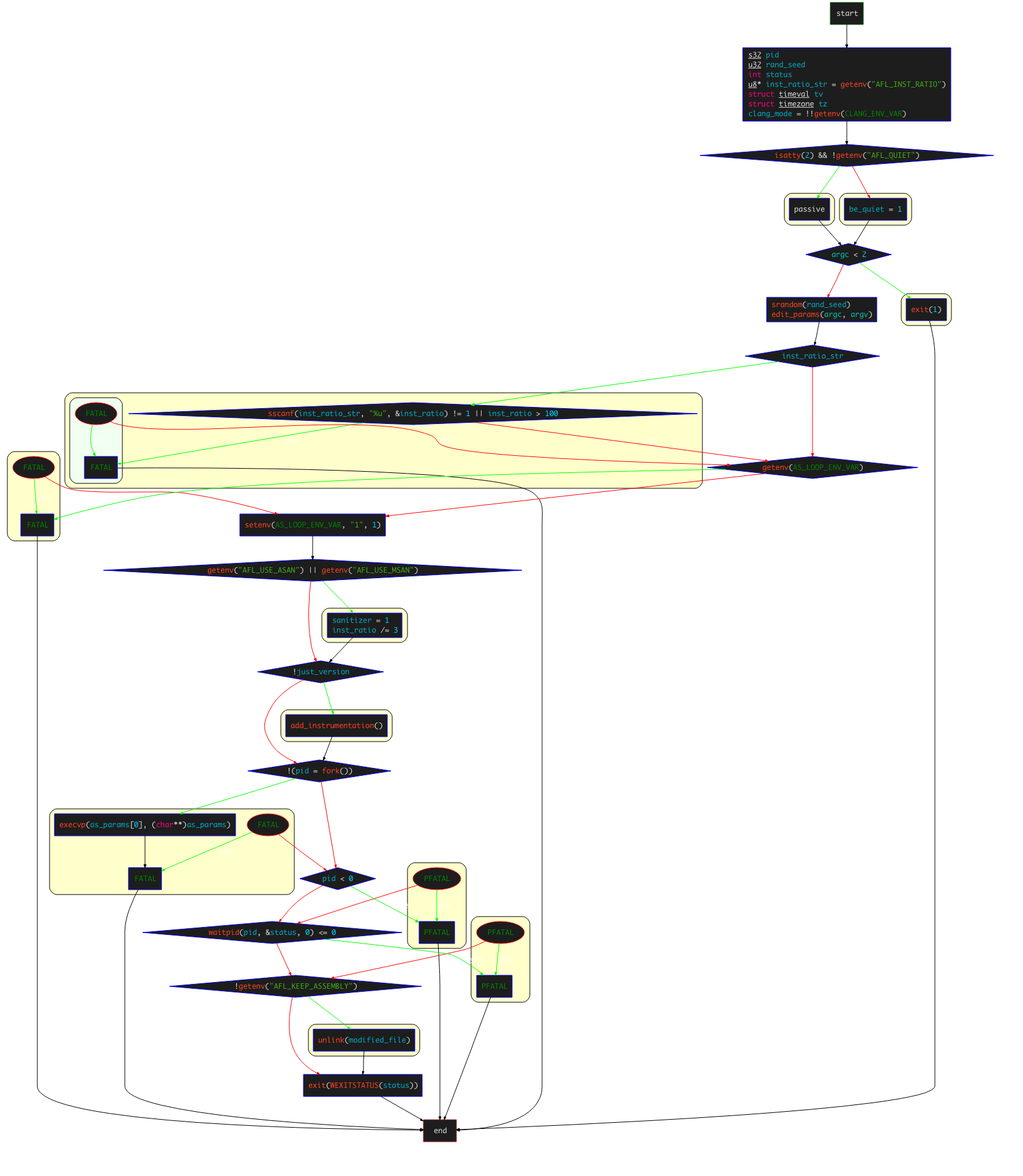
可以通过在main函数中添加如下代码来打印实际执行的参数:

在插桩完成后,会生成 .s 文件,内容如下(具体的文件位置与设置的环境变量相关):
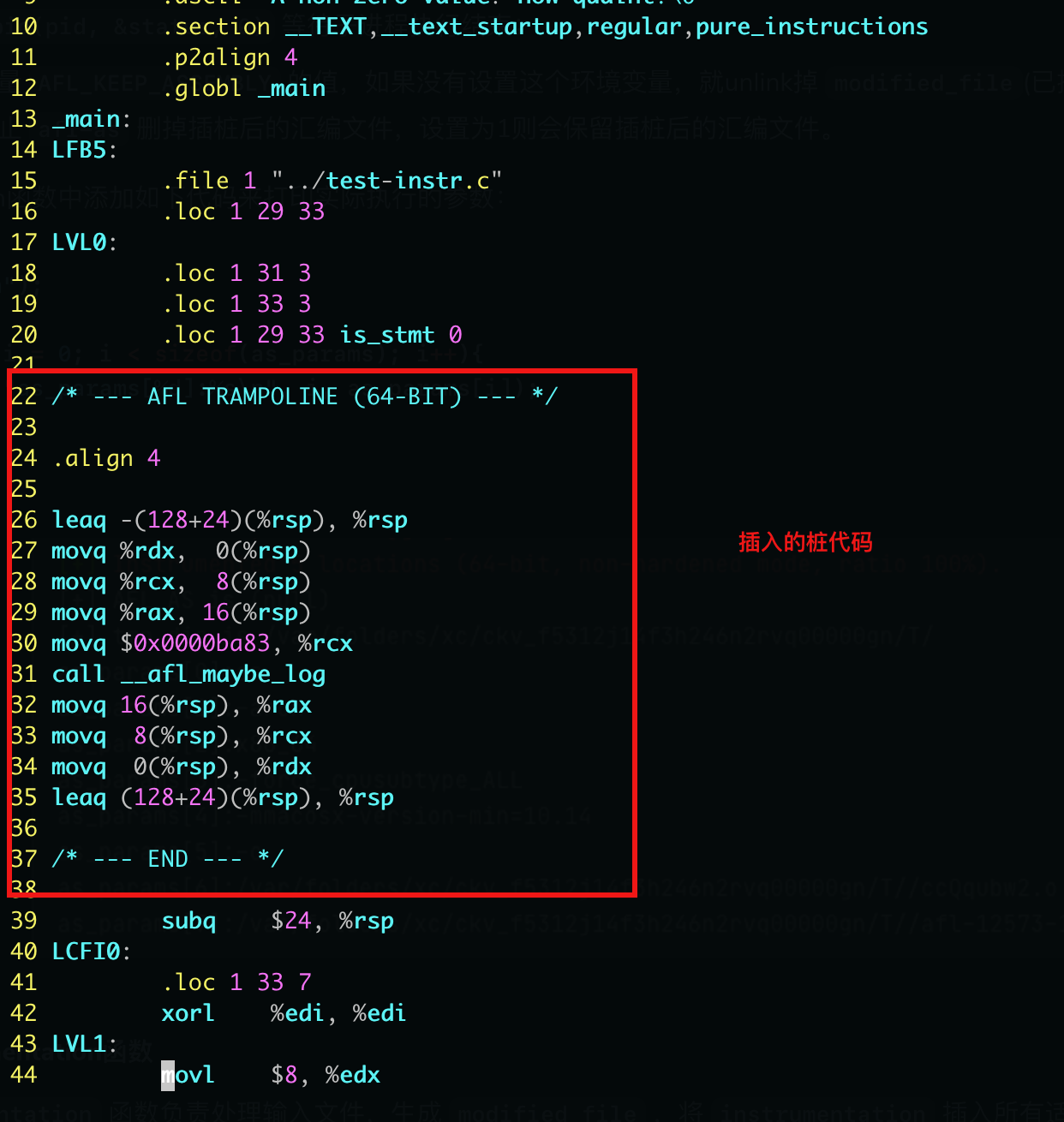
add_instrumentation 函数负责处理输入文件,生成 modified_file ,将 instrumentation 插入所有适当的位置。其整体控制流程如下:

整体逻辑看上去有点复杂,但是关键内容并不算很多。在main函数中调用完 edit_params() 函数完成 as_params 参数数组的处理后,进入到该函数。
判断 input_file 是否为空,如果不为空则尝试打开文件获取fd赋值给 inf,失败则抛出异常;input_file 为空则 inf 设置为标准输入;
打开 modified_file ,获取fd赋值给 outfd,失败返回异常;进一步验证该文件是否可写,不可写返回异常;
while 循环读取 inf 指向文件的每一行到 line 数组,每行最多 MAX_LINE = 8192个字节(含末尾的‘\0’),从line数组里将读取到的内容写入到 outf 指向的文件,然后进入到真正的插桩逻辑。这里需要注意的是,插桩只向 .text 段插入,:
首先跳过标签、宏、注释;
这里结合部分关键代码进行解释。需要注意的是,变量 instr_ok 本质上是一个flag,用于表示是否位于.text段。变量设置为1,表示位于 .text 中,如果不为1,则表示不再。于是,如果instr_ok 为1,就会在分支处执行插桩逻辑,否则就不插桩。
首先判断读入的行是否以‘\t’ 开头,本质上是在匹配.s文件中声明的段,然后判断line[1]是否为.:
接下来通过几个 if 判断,来设置一些标志信息,包括 off-flavor assembly,Intel/AT&T的块处理方式、ad-hoc __asm__块的处理方式等;
AFL在插桩时重点关注的内容包括:^main, ^.L0, ^.LBB0_0, ^\tjnz foo (_main函数, gcc和clang下的分支标记,条件跳转分支标记),这些内容通常标志了程序的流程变化,因此AFL会重点在这些位置进行插桩:
对于形如\tj[^m].格式的指令,即条件跳转指令,且R(100)产生的随机数小于插桩密度inst_ratio,直接使用fprintf将trampoline_fmt_64(插桩部分的指令)写入 outf 指向的文件,写入大小为小于 MAP_SIZE的随机数——R(MAP_SIZE)
,然后插桩计数ins_lines加一,continue 跳出,进行下一次遍历;
对于label的相关评估,有一些label可能是一些分支的目的地,需要自己的评判
首先检查该行中是否存在:,然后检查是否以.开始
如果以.开始,则代表想要插桩^.L0:或者 ^.LBB0_0:这样的branch label,即 style jump destination
上述过程完成后,来到 while 循环的下一个循环,在 while 的开头,可以看到对以 defered mode 进行插桩的位置进行了真正的插桩处理:
这里对 instr_ok, instrument_next 变量进行了检验是否为1,而且进一步校验是否位于 .text 段中,且设置了 defered mode 进行插桩,则就进行插桩操作,写入 trampoline_fmt_64/32 。
至此,插桩函数 add_instrumentation 的主要逻辑已梳理完成。
edit_params,该函数主要是设置变量 as_params 的值,以及 use_64bit/modified_file 的值, 其整体控制流程如下:

获取环境变量 TMPDIR 和 AFL_AS;
对于 __APPLE_ 宏, 如果当前在 clang_mode 且没有设置 AFL_AS 环境变量,会设置 use_clang_mode = 1,并设置 afl-as 为 AFL_CC/AFL_CXX/clang中的一种;
设置 tmp_dir ,尝试获取的环境变量依次为 TEMP, TMP,如果都失败,则直接设置为 /tmp;
调用 ck_alloc() 函数为 as_params 参数数组分配内存,大小为(argc + 32) * 8;
设置 afl-as 路径:as_params[0] = afl_as ? afl_as : (u8*)"as";
设置 as_params[argc] = 0; ,as_par_cnt 初始值为1;
遍历从 argv[1] 到 argv[argc-1] 之前的每个 argv:
开始设置其他参数:
对于 __APPLE__,如果设置了 use_clang_as,则追加 -c -x assembler;
设置 input_file 变量:input_file = argv[argc - 1];,把最后一个参数的值作为 input_file;
如果 input_file 的首字符为-:
如果 input_file 首字符不为-,比较 input_file 和 tmp_dir、/var/tmp 、/tmp/的前 strlen(tmp_dir)/9/5个字节是否相同,如果不相同,就设置 pass_thru 为1;
设置 modified_file:`modified_file = alloc_printf("%s/.afl-%u-%u.s", tmp_dir, getpid(),
trampoline 的含义是“蹦床”,直译过来就是“插桩蹦床”。个人感觉直接使用英文更能表达出其代表的真实含义和作用,可以简单理解为桩代码。
根据前面内容知道,在64位环境下,AFL会插入 trampoline_fmt_64 到文件中,在32位环境下,AFL会插入trampoline_fmt_32 到文件中。trampoline_fmt_64/32定义在 afl-as.h 头文件中:
上面列出的插桩代码与我们在 .s 文件和IDA逆向中看到的插桩代码是一样的:
.s 文件中的桩代码:
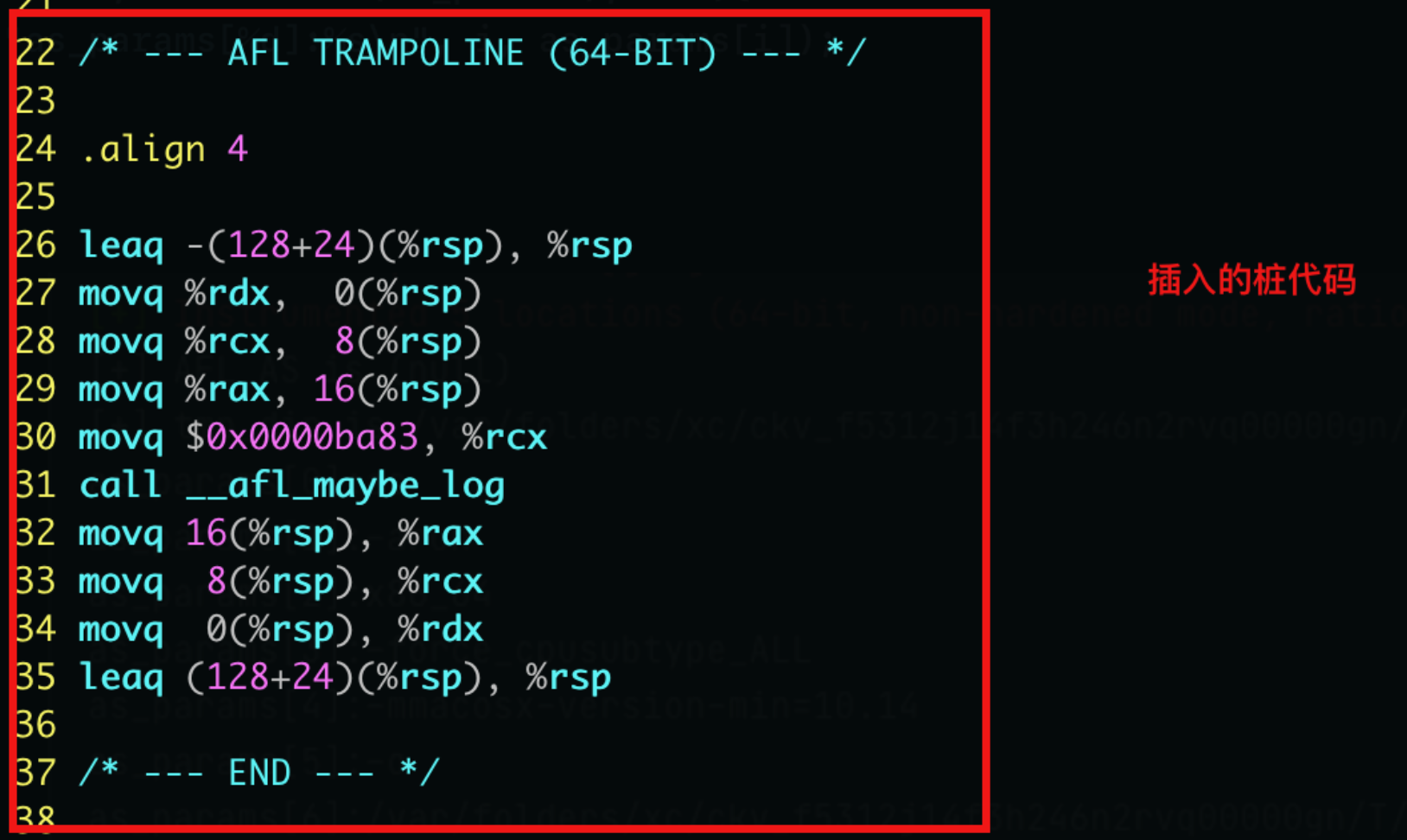
IDA逆向中显示的桩代码:

上述代码执行的主要功能包括:
在以上的功能中, __afl_maybe_log 才是核心内容。
从 __afl_maybe_log 函数开始,后续的处理流程大致如下(图片来自ScUpax0s师傅):

首先对上面流程中涉及到的几个bss段的变量进行简单说明(以64位为例,从main_payload_64中提取):
说明
以下介绍的指令段均来自于 main_payload_64 。
首先,使用 lahf 指令(加载状态标志位到AH)将EFLAGS寄存器的低八位复制到 AH,被复制的标志位包括:符号标志位(SF)、零标志位(ZF)、辅助进位标志位(AF)、奇偶标志位(PF)和进位标志位(CF),使用该指令可以方便地将标志位副本保存在变量中;
然后,使用 seto 指令溢出置位;
接下来检查共享内存是否进行了设置,判断 __afl_area_ptr 是否为NULL:
该部分的主要作用为初始化 __afl_area_ptr ,且只在运行到第一个桩时进行本次初始化。
首先,如果 __afl_setup_failure 不为0,直接跳转到 __afl_return 返回;
然后,检查 __afl_global_area_ptr 文件指针是否为NULL:
首先,保存所有寄存器的值,包括 xmm 寄存器组;
然后,进行 rsp 的对齐;
然后,获取环境变量 __AFL_SHM_ID,该环境变量保存的是共享内存的ID:
接下来,将 _shmat 返回的共享内存地址存储在 __afl_area_ptr 和 __afl_global_area_ptr 变量中。
后面即开始运行 __afl_forkserver。
这一段实现的主要功能是向 FORKSRV_FD+1 (也就是198+1)号描述符(即状态管道)中写 __afl_temp 中的4个字节,告诉 fork server (将在后续的文章中进行详细解释)已经成功启动。
我们直接看反编译的代码:

这里第一步的异或中的 a4 ,其实是调用 __afl_maybe_log 时传入 的参数:

再往上追溯到插桩代码:

可以看到传入 rcx 的,实际上就是用于标记当前桩的随机id, 而 _afl_prev_loc 其实是上一个桩的随机id。
经过两次异或之后,再将 _afl_prev_loc 右移一位作为新的 _afl_prev_loc,最后再共享内存中存储当前插桩位置的地方计数加一。
本文综合分析了AFL中的gcc部分和插桩部分的源代码,由衷佩服AFL设计开发者的巧妙思路和高超的开发技巧,不愧是开启了fuzzing新时代的、影响力巨大的fuzz工具。
衷心感谢乐于分享的师傅们,能让我站在巨人的肩膀上。
static u8* as_path; /* Path to the AFL 'as' wrapper,AFL的as的路径 */
static u8** cc_params; /* Parameters passed to the real CC,CC实际使用的编译器参数 */
static u32 cc_par_cnt = 1; /* Param count, including argv0 ,参数计数 */
static u8 be_quiet, /* Quiet mode,静默模式 */
clang_mode; /* Invoked as afl-clang*? ,是否使用afl-clang*模式 */
static u8* as_path; /* Path to the AFL 'as' wrapper,AFL的as的路径 */
static u8** cc_params; /* Parameters passed to the real CC,CC实际使用的编译器参数 */
static u32 cc_par_cnt = 1; /* Param count, including argv0 ,参数计数 */
static u8 be_quiet, /* Quiet mode,静默模式 */
clang_mode; /* Invoked as afl-clang*? ,是否使用afl-clang*模式 */
static u8** as_params; /* Parameters passed to the real 'as',传递给as的参数 */
static u8* input_file; /* Originally specified input file ,输入文件 */
static u8* modified_file; /* Instrumented file for the real 'as',as进行插桩处理的文件 */
static u8 be_quiet, /* Quiet mode (no stderr output) ,静默模式,没有标准输出 */
clang_mode, /* Running in clang mode? 是否运行在clang模式 */
pass_thru, /* Just pass data through? 只通过数据 */
just_version, /* Just show version? 只显示版本 */
sanitizer; /* Using ASAN / MSAN 是否使用ASAN/MSAN */
static u32 inst_ratio = 100, /* Instrumentation probability (%) 插桩覆盖率 */
as_par_cnt = 1; /* Number of params to 'as' 传递给as的参数数量初始值 */
static u8** as_params; /* Parameters passed to the real 'as',传递给as的参数 */
static u8* input_file; /* Originally specified input file ,输入文件 */
static u8* modified_file; /* Instrumented file for the real 'as',as进行插桩处理的文件 */
static u8 be_quiet, /* Quiet mode (no stderr output) ,静默模式,没有标准输出 */
clang_mode, /* Running in clang mode? 是否运行在clang模式 */
pass_thru, /* Just pass data through? 只通过数据 */
just_version, /* Just show version? 只显示版本 */
sanitizer; /* Using ASAN / MSAN 是否使用ASAN/MSAN */
static u32 inst_ratio = 100, /* Instrumentation probability (%) 插桩覆盖率 */
as_par_cnt = 1; /* Number of params to 'as' 传递给as的参数数量初始值 */
print("\n");
for (int i = 0; i < sizeof(as_params); i++){
peinrf("as_params[%d]:%s\n", i, as_params[i]);
}
print("\n");
for (int i = 0; i < sizeof(as_params); i++){
peinrf("as_params[%d]:%s\n", i, as_params[i]);
}
if (line[0] == '\t' && line[1] == '.') {
/* OpenBSD puts jump tables directly inline with the code, which is
a bit annoying. They use a specific format of p2align directives
around them, so we use that as a signal. */
if (!clang_mode && instr_ok && !strncmp(line + 2, "p2align ", 8) &&
isdigit(line[10]) && line[11] == '\n') skip_next_label = 1;
if (!strncmp(line + 2, "text\n", 5) ||
!strncmp(line + 2, "section\t.text", 13) ||
!strncmp(line + 2, "section\t__TEXT,__text", 21) ||
!strncmp(line + 2, "section __TEXT,__text", 21)) {
instr_ok = 1;
continue;
}
if (!strncmp(line + 2, "section\t", 8) ||
!strncmp(line + 2, "section ", 8) ||
!strncmp(line + 2, "bss\n", 4) ||
!strncmp(line + 2, "data\n", 5)) {
instr_ok = 0;
continue;
}
}
if (line[0] == '\t' && line[1] == '.') {
/* OpenBSD puts jump tables directly inline with the code, which is
a bit annoying. They use a specific format of p2align directives
around them, so we use that as a signal. */
if (!clang_mode && instr_ok && !strncmp(line + 2, "p2align ", 8) &&
isdigit(line[10]) && line[11] == '\n') skip_next_label = 1;
if (!strncmp(line + 2, "text\n", 5) ||
!strncmp(line + 2, "section\t.text", 13) ||
!strncmp(line + 2, "section\t__TEXT,__text", 21) ||
!strncmp(line + 2, "section __TEXT,__text", 21)) {
instr_ok = 1;
continue;
}
if (!strncmp(line + 2, "section\t", 8) ||
!strncmp(line + 2, "section ", 8) ||
!strncmp(line + 2, "bss\n", 4) ||
!strncmp(line + 2, "data\n", 5)) {
instr_ok = 0;
continue;
}
}
/* Detect off-flavor assembly (rare, happens in gdb). When this is
encountered, we set skip_csect until the opposite directive is
seen, and we do not instrument. */
if (strstr(line, ".code")) {
if (strstr(line, ".code32")) skip_csect = use_64bit;
if (strstr(line, ".code64")) skip_csect = !use_64bit;
}
/* Detect syntax changes, as could happen with hand-written assembly.
Skip Intel blocks, resume instrumentation when back to AT&T. */
if (strstr(line, ".intel_syntax")) skip_intel = 1;
if (strstr(line, ".att_syntax")) skip_intel = 0;
/* Detect and skip ad-hoc __asm__ blocks, likewise skipping them. */
if (line[0] == '#' || line[1] == '#') {
if (strstr(line, "#APP")) skip_app = 1;
if (strstr(line, "#NO_APP")) skip_app = 0;
}
/* Detect off-flavor assembly (rare, happens in gdb). When this is
encountered, we set skip_csect until the opposite directive is
seen, and we do not instrument. */
if (strstr(line, ".code")) {
if (strstr(line, ".code32")) skip_csect = use_64bit;
if (strstr(line, ".code64")) skip_csect = !use_64bit;
}
/* Detect syntax changes, as could happen with hand-written assembly.
Skip Intel blocks, resume instrumentation when back to AT&T. */
if (strstr(line, ".intel_syntax")) skip_intel = 1;
if (strstr(line, ".att_syntax")) skip_intel = 0;
/* Detect and skip ad-hoc __asm__ blocks, likewise skipping them. */
if (line[0] == '#' || line[1] == '#') {
if (strstr(line, "#APP")) skip_app = 1;
if (strstr(line, "#NO_APP")) skip_app = 0;
}
/* If we're in the right mood for instrumenting, check for function
names or conditional labels. This is a bit messy, but in essence,
we want to catch:
^main: - function entry point (always instrumented)
^.L0: - GCC branch label
^.LBB0_0: - clang branch label (but only in clang mode)
^\tjnz foo - conditional branches
...but not:
^
^
^.Ltmp0: - clang non-branch labels
^.LC0 - GCC non-branch labels
^.LBB0_0: - ditto (when in GCC mode)
^\tjmp foo - non-conditional jumps
Additionally, clang and GCC on MacOS X follow a different convention
with no leading dots on labels, hence the weird maze of
later on.
*/
if (skip_intel || skip_app || skip_csect || !instr_ok ||
line[0] == '#' || line[0] == ' ') continue;
/* Conditional branch instruction (jnz, etc). We append the instrumentation
right after the branch (to instrument the not-taken path) and at the
branch destination label (handled later on). */
if (line[0] == '\t') {
if (line[1] == 'j' && line[2] != 'm' && R(100) < inst_ratio) {
fprintf(outf, use_64bit ? trampoline_fmt_64 : trampoline_fmt_32,
R(MAP_SIZE));
ins_lines++;
}
continue;
}
/* If we're in the right mood for instrumenting, check for function
names or conditional labels. This is a bit messy, but in essence,
we want to catch:
^main: - function entry point (always instrumented)
^.L0: - GCC branch label
^.LBB0_0: - clang branch label (but only in clang mode)
^\tjnz foo - conditional branches
...but not:
^
^
^.Ltmp0: - clang non-branch labels
^.LC0 - GCC non-branch labels
^.LBB0_0: - ditto (when in GCC mode)
^\tjmp foo - non-conditional jumps
Additionally, clang and GCC on MacOS X follow a different convention
with no leading dots on labels, hence the weird maze of
later on.
*/
if (skip_intel || skip_app || skip_csect || !instr_ok ||
line[0] == '#' || line[0] == ' ') continue;
/* Conditional branch instruction (jnz, etc). We append the instrumentation
right after the branch (to instrument the not-taken path) and at the
branch destination label (handled later on). */
if (line[0] == '\t') {
if (line[1] == 'j' && line[2] != 'm' && R(100) < inst_ratio) {
fprintf(outf, use_64bit ? trampoline_fmt_64 : trampoline_fmt_32,
R(MAP_SIZE));
ins_lines++;
}
continue;
}
/* Label of some sort. This may be a branch destination, but we need to
tread carefully and account for several different formatting
conventions. */
/* Apple: L<whatever><digit>: */
if ((colon_pos = strstr(line, ":"))) {
if (line[0] == 'L' && isdigit(*(colon_pos - 1))) {
/* Everybody else: .L<whatever>: */
if (strstr(line, ":")) {
if (line[0] == '.') {
/* .L0: or LBB0_0: style jump destination */
/* Apple: L<num> / LBB<num> */
if ((isdigit(line[1]) || (clang_mode && !strncmp(line, "LBB", 3)))
&& R(100) < inst_ratio) {
/* Apple: .L<num> / .LBB<num> */
if ((isdigit(line[2]) || (clang_mode && !strncmp(line + 1, "LBB", 3)))
&& R(100) < inst_ratio) {
/* An optimization is possible here by adding the code only if the
label is mentioned in the code in contexts other than call / jmp.
That said, this complicates the code by requiring two-pass
processing (messy with stdin), and results in a speed gain
typically under 10%, because compilers are generally pretty good
about not generating spurious intra-function jumps.
We use deferred output chiefly to avoid disrupting
.Lfunc_begin0-style exception handling calculations (a problem on
MacOS X). */
if (!skip_next_label) instrument_next = 1; else skip_next_label = 0;
}
} else {
/* Function label (always instrumented, deferred mode). */
instrument_next = 1;
}
}
}
/* Label of some sort. This may be a branch destination, but we need to
tread carefully and account for several different formatting
conventions. */
/* Apple: L<whatever><digit>: */
if ((colon_pos = strstr(line, ":"))) {
if (line[0] == 'L' && isdigit(*(colon_pos - 1))) {
/* Everybody else: .L<whatever>: */
if (strstr(line, ":")) {
if (line[0] == '.') {
/* .L0: or LBB0_0: style jump destination */
/* Apple: L<num> / LBB<num> */
if ((isdigit(line[1]) || (clang_mode && !strncmp(line, "LBB", 3)))
&& R(100) < inst_ratio) {
/* Apple: .L<num> / .LBB<num> */
if ((isdigit(line[2]) || (clang_mode && !strncmp(line + 1, "LBB", 3)))
&& R(100) < inst_ratio) {
/* An optimization is possible here by adding the code only if the
label is mentioned in the code in contexts other than call / jmp.
That said, this complicates the code by requiring two-pass
processing (messy with stdin), and results in a speed gain
typically under 10%, because compilers are generally pretty good
about not generating spurious intra-function jumps.
We use deferred output chiefly to avoid disrupting
.Lfunc_begin0-style exception handling calculations (a problem on
MacOS X). */
if (!skip_next_label) instrument_next = 1; else skip_next_label = 0;
}
} else {
/* Function label (always instrumented, deferred mode). */
instrument_next = 1;
}
}
}
if (!pass_thru && !skip_intel && !skip_app && !skip_csect && instr_ok &&
instrument_next && line[0] == '\t' && isalpha(line[1])) {
fprintf(outf, use_64bit ? trampoline_fmt_64 : trampoline_fmt_32,
R(MAP_SIZE));
instrument_next = 0;
ins_lines++;
}
if (!pass_thru && !skip_intel && !skip_app && !skip_csect && instr_ok &&
instrument_next && line[0] == '\t' && isalpha(line[1])) {
fprintf(outf, use_64bit ? trampoline_fmt_64 : trampoline_fmt_32,
R(MAP_SIZE));
instrument_next = 0;
ins_lines++;
}
(u32)time(NULL));`,即为`tmp_dir/afl-pid-tim.s` 格式的字符串
(u32)time(NULL));`,即为`tmp_dir/afl-pid-tim.s` 格式的字符串
static const u8* trampoline_fmt_32 =
"\n"
"/* --- AFL TRAMPOLINE (32-BIT) --- */\n"
"\n"
".align 4\n"
"\n"
"leal -16(%%esp), %%esp\n"
"movl %%edi, 0(%%esp)\n"
"movl %%edx, 4(%%esp)\n"
"movl %%ecx, 8(%%esp)\n"
"movl %%eax, 12(%%esp)\n"
"movl $0x%08x, %%ecx\n" // 向ecx中存入识别代码块的随机桩代码id
"call __afl_maybe_log\n" // 调用 __afl_maybe_log 函数
"movl 12(%%esp), %%eax\n"
"movl 8(%%esp), %%ecx\n"
"movl 4(%%esp), %%edx\n"
"movl 0(%%esp), %%edi\n"
"leal 16(%%esp), %%esp\n"
"\n"
"/* --- END --- */\n"
"\n";
static const u8* trampoline_fmt_64 =
"\n"
"/* --- AFL TRAMPOLINE (64-BIT) --- */\n"
"\n"
".align 4\n"
"\n"
"leaq -(128+24)(%%rsp), %%rsp\n"
"movq %%rdx, 0(%%rsp)\n"
"movq %%rcx, 8(%%rsp)\n"
"movq %%rax, 16(%%rsp)\n"
"movq $0x%08x, %%rcx\n" // 64位下使用的寄存器为rcx
"call __afl_maybe_log\n" // 调用 __afl_maybe_log 函数
"movq 16(%%rsp), %%rax\n"
"movq 8(%%rsp), %%rcx\n"
"movq 0(%%rsp), %%rdx\n"
"leaq (128+24)(%%rsp), %%rsp\n"
"\n"
"/* --- END --- */\n"
"\n";
static const u8* trampoline_fmt_32 =
"\n"
"/* --- AFL TRAMPOLINE (32-BIT) --- */\n"
"\n"
".align 4\n"
"\n"
"leal -16(%%esp), %%esp\n"
"movl %%edi, 0(%%esp)\n"
"movl %%edx, 4(%%esp)\n"
"movl %%ecx, 8(%%esp)\n"
"movl %%eax, 12(%%esp)\n"
"movl $0x%08x, %%ecx\n" // 向ecx中存入识别代码块的随机桩代码id
"call __afl_maybe_log\n" // 调用 __afl_maybe_log 函数
"movl 12(%%esp), %%eax\n"
"movl 8(%%esp), %%ecx\n"
"movl 4(%%esp), %%edx\n"
"movl 0(%%esp), %%edi\n"
"leal 16(%%esp), %%esp\n"
"\n"
"/* --- END --- */\n"
"\n";
static const u8* trampoline_fmt_64 =
"\n"
"/* --- AFL TRAMPOLINE (64-BIT) --- */\n"
"\n"
".align 4\n"
"\n"
"leaq -(128+24)(%%rsp), %%rsp\n"
"movq %%rdx, 0(%%rsp)\n"
"movq %%rcx, 8(%%rsp)\n"
"movq %%rax, 16(%%rsp)\n"
"movq $0x%08x, %%rcx\n" // 64位下使用的寄存器为rcx
"call __afl_maybe_log\n" // 调用 __afl_maybe_log 函数
"movq 16(%%rsp), %%rax\n"
"movq 8(%%rsp), %%rcx\n"
"movq 0(%%rsp), %%rdx\n"
"leaq (128+24)(%%rsp), %%rsp\n"
"\n"
"/* --- END --- */\n"
"\n";
.AFL_VARS:
.comm __afl_area_ptr, 8
.comm __afl_prev_loc, 8
.comm __afl_fork_pid, 4
.comm __afl_temp, 4
.comm __afl_setup_failure, 1
.comm __afl_global_area_ptr, 8, 8
.AFL_VARS:
.comm __afl_area_ptr, 8
.comm __afl_prev_loc, 8
.comm __afl_fork_pid, 4
.comm __afl_temp, 4
.comm __afl_setup_failure, 1
.comm __afl_global_area_ptr, 8, 8
__afl_maybe_log: /* 源码删除无关内容后 */
lahf
seto %al
/* Check if SHM region is already mapped. */
movq __afl_area_ptr(%rip), %rdx
testq %rdx, %rdx
je __afl_setup
__afl_maybe_log: /* 源码删除无关内容后 */
lahf
seto %al
/* Check if SHM region is already mapped. */
movq __afl_area_ptr(%rip), %rdx
testq %rdx, %rdx
je __afl_setup
[培训]内核驱动高级班,冲击BAT一流互联网大厂工作,每周日13:00-18:00直播授课
最后于 2021-9-27 17:00
被有毒编辑
,原因: